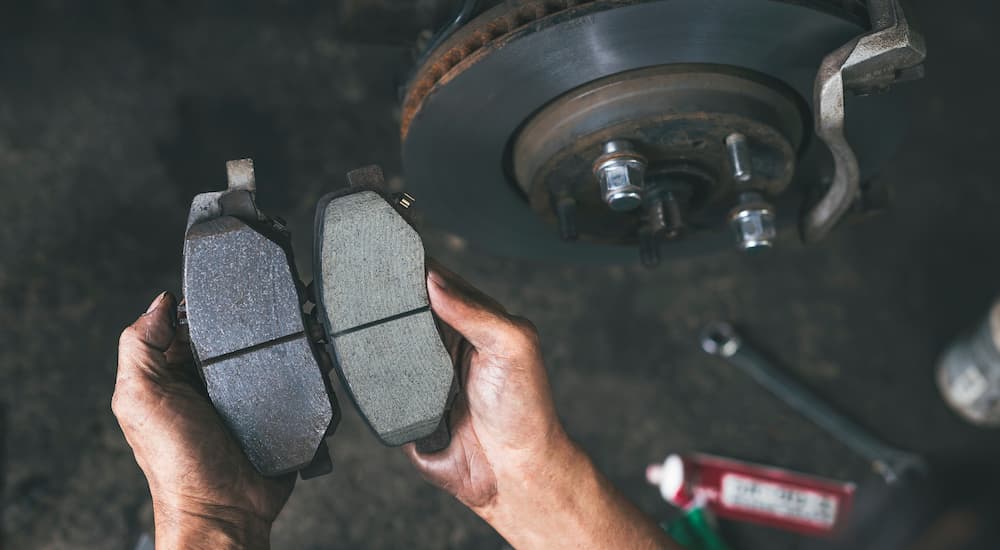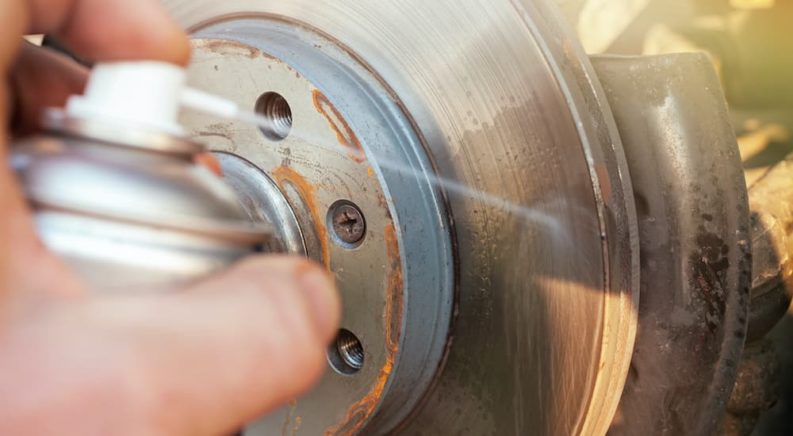Given the role your brakes play in your automotive safety, there’s no underestimating the importance of a regular brake service. Bringing a one-and-a-half-ton vehicle to a stop is no small task, requiring a number of vital components to work in complete harmony every time you press the brake pedal. Of these, the brake calipers play an important part, doing the brunt of the work in engaging the brakes, so you always want to ensure they’re in good working order.
So what should drivers look for when diagnosing brake caliper issues, how do you fix them, and what causes these problems in the first place? We’ll explore all that and more as we guide you through a little Brake Caliper 101…
How Do Calipers Get Stuck?
For those who skipped shop class, the brake calipers are essentially the housing for your brake pads. When you step on the brake pedal, the hydraulic brake fluid causes the pressure to build up in your brake lines, engaging a piston that forces both sides of the brake caliper together, causing the brake pads to make contact with the brake rotors. The resulting friction is responsible for bringing your vehicle to a stop, which is why it’s so important to quickly and accurately diagnose and fix a brake caliper-related issue.
Seized Brake Caliper Piston: Your brake caliper pistons are responsible for bringing the brake pad into contact with the brake rotors, so they’re one of the first things you should check when you think you might be dealing with a stuck caliper. Brake caliper pistons are designed with rubber boots that protect their components from dirt, debris, rust, and other gunk you might encounter on your drive. If this component becomes torn or damaged, the piston will not be able to move freely, which can cause the brake caliper to become locked in place. While this issue can occur on its own, it’s often the result of a poor brake pad replacement job. If a seized caliper piston occurs shortly after a brake pad replacement, don’t be afraid to ask your mechanic to rectify the issue on their dime.
Seized Slide Pins: The brake caliper piston does the brunt of the work when it comes to engaging your brakes, but the slide pins also play an important role. Located near the piston, these slide pins guide the pad towards the rotor, ensuring smooth and even braking. Like the brake caliper pistons, the slide pin bores are usually protected by a rubber boot. If these slide pins become corroded or otherwise damaged, or the rubber boot fails, it can cause the brake caliper to lock into place.
Dirty Brake Pad Shims: A brake pad shim is an important barrier between the caliper and the brake pad itself, reducing the noise and vibration that occur when the brakes are engaged. Over time, these brake pad shims can collect all sorts of brake dust and other contaminants. If the build-up reaches a certain level, it can begin to interfere with the brake calipers and cause them to seize up.
Faulty Brake Line or Hose: Your brakes are engaged using hydraulic force that pressurizes the brake lines every time you step on the pedal. This system requires a network of brake lines and hoses that weave to every corner of your vehicle, and while they should last the length of the vehicle, that’s not always the case. A collapsed brake hose will cause brake fluid to become trapped against the caliper’s piston, which will prevent the brakes from disengaging when the pedal is released. Similarly, brake line obstructions can also impede the flow of brake fluid, which can easily lead to a stuck caliper.

Signs of a Stuck Caliper
Depending on the severity of the issue, it can be tough to differentiate a stuck caliper from any number of other automotive maladies. Luckily, there are a few tell-tale symptoms that should help to narrow it down. From weird smells and abnormal noises to reduced fuel economy and even smoke, let’s take a look at some of the common signs of a stuck brake caliper…
Noise: When dealing with a stuck brake caliper, a strange noise might be your first clue. A stuck caliper will cause the brake pad to make constant contact with the rotor, which will cause uneven wear on the pad itself; this, in turn, will usually produce a distinctive scraping or grinding noise. Of course, older, worn-out brakes also tend to make a lot of noise, but if the racket is isolated to one wheel, it’s a sign that you might be looking at a stuck caliper. In rare cases, it could be something like a small pebble or piece of road debris caught between the pad and the rotor, but this is less common.
Burning Smell or Smoke: When it comes to diagnosing your vehicle, all five senses can come in handy. Brakes rely on friction to get the job done, but when a brake caliper is stuck into a closed position, it’s all too easy to produce a little too much friction; this can cause the brake pad and rotor to heat up to a dangerous level and produce an offensive burning odor. In extreme cases, this excess friction can even cause the pads themselves to smoke, which is an easy—if unfortunate—way of pinpointing the affected wheel. Even if your brakes haven’t reached the point where they’re smoking, an overheated brake can also cause brake fade, a dangerous issue that drastically reduces braking power and leads to no shortage of safety concerns.
Steering Issues: If it seems like your vehicle is pulling to one side—subtly drifting to either the left or right—a stuck caliper is a prime culprit. When a brake caliper becomes stuck, the wheel with the stuck caliper simply won’t rotate as quickly as the other unimpeded wheels; this will cause the vehicle to pull to the left in the case of a stuck right brake caliper and to the right if you’re dealing with a stuck left brake caliper. That said, there are a number of things that can cause a vehicle to drift to one side, from underinflated tires and misaligned wheels to low brake fluid or even an issue with the steering or suspension. The excessive heat produced by a stuck caliper can also warp the brake rotor itself; this can cause a vehicle’s steering wheel to vibrate, so that’s another area to keep an eye on if you suspect caliper-related issues.
Poor Fuel Economy: It stands to reason that a vehicle that’s fighting against itself just to roll down the road will not be at its best from a fuel economy perspective. When a vehicle’s engine is fighting against a stuck brake caliper, drivers will likely see a reduction in fuel economy. This can range from a few miles per gallon to as much as a 25% reduction in fuel economy, which is why it’s always a good idea to track your vehicle’s fuel economy over time. This figure is bound to reduce as a vehicle ages, but if you see a sudden, dramatic loss in fuel efficiency or it feels like the vehicle is slowing down without the driver pressing the brake, check the calipers.
How to Fix a Stuck Caliper
Brake caliper issues can generally be grouped into two categories: those that can be resolved with some quick cleaning and lubricant and those that require a wholesale replacement or rebuild. If you’re dealing with a gunked-up slider pin bore or brake pad shim, for example, you’ll just need a little cleaning, a quick spritz of lubricant, and you’re off to the races. If your pads are seriously stuck, resurfacing the rotor and disc and replacing the brake pads will also do the trick.
Unfortunately, brake caliper issues are rarely so easy to deal with. If you’re facing a seized caliper piston or slide pin, the repair will require some specialized tools like a brake caliper press tool or brake hone. While these are available for as little as $15 to $25 online, it’s important to be realistic about your technical know-how before tackling such a project.
Do you know what every part of your brake assembly does and how to strip it down, clean it, and put it back together? If not, it raises the question: Is it worth it? When it comes to something as vital to your safety as your vehicle’s brakes, it’s often best to leave the job to a professional. An experienced mechanic might charge anywhere from $150 to $600 to fix a stuck caliper, but that’s the price to pay for the peace of mind that a seasoned professional can provide.
Then there’s the whole debate between repairing and replacing. If your stuck calipers are the results of a freak accident or one-off exposure to some particularly nasty contaminates, a simple cleaning might do the job, but in many cases, a brake caliper that fails once is going to keep failing over and over again until it’s replaced. If the issue is due to a compromised rubber boot or corrosion deep within the piston or side pin bores, no amount of scrubbing and lubricating is going to fix the problem, and you’d probably just be better off replacing the whole caliper.
Rebuilding is another option, but again, it should be left to those who are a little more confident in their mechanical abilities. Rebuilding a caliper involves removing the caliper, plugging the brake hose, disassembling the caliper, inspecting and cleaning the caliper bore, putting everything back together, and reinstalling it in the vehicle. If you’re feeling ambitious, there are plenty of YouTube videos and online how-tos on the subject, so make sure you study up before tinkering with a component that plays such an important role in your safety.

Caliper Calypso, Brake Disc Disco
Being able to recognize the signs and symptoms of stuck brake calipers is an important skill for any driver. Whether it’s a burning smell, reduced fuel economy, smoke, or a vehicle that wants to pull to the left or right, knowing what to look out for can make all the difference.
Brake caliper issues can be tough to track down, but a quick check on the usual suspects is an easy way to narrow down the problem and figure out the proper fix. Again, we’d advise most drivers to head straight for their local mechanic or dealership if they suspect an issue related to their brake calipers.
While there are some automotive maintenance and repair tasks that are well within reach of the average driver, your vehicle’s safety systems are another story altogether. If you’re the type of driver who doesn’t know one end of a wrench from another or has to chant “lefty loosey…” every trim they grab one, this is a job best left to the pros.

